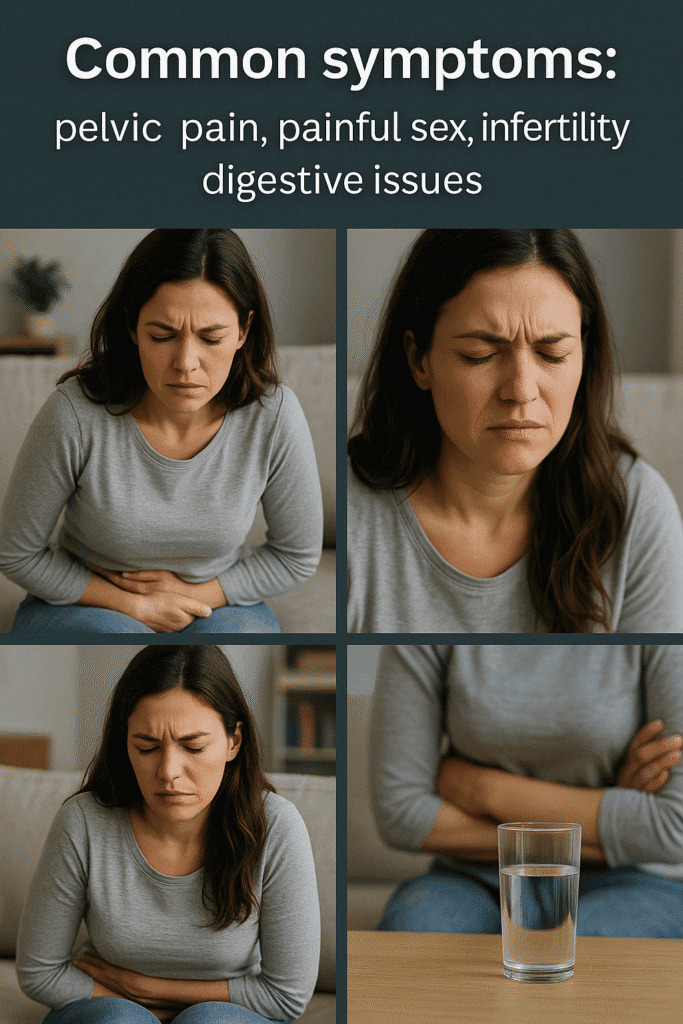
Understanding Endometriosis: What is Endometriosis?
Endometriosis is a condition where tissue similar to the endometrial lining of the uterus grows outside the uterus, typically on the ovaries, fallopian tubes, peritoneum, and other pelvic structures. In rare cases, endometriosis can be found in distant organs, such as the lungs (pulmonary endometriosis).
This ectopic tissue behaves similarly to the normal endometrium, thickening and shedding during the menstrual cycle. However, because it has no way to exit the body, it leads to inflammation, pain, and scar tissue formation.
Common Symptoms of Endometriosis
The symptoms of endometriosis vary from mild to severe and often overlap with other gynecological conditions, making diagnosis challenging. Here are the most common symptoms:
1. Chronic Pelvic Pain
- Persistent pelvic pain is one of the hallmark symptoms of endometriosis.
- Pain can be cyclic (worsening around menstruation) or constant.
2. Dysmenorrhea (Painful Periods)
- Severe menstrual cramps that do not improve with standard pain relief methods.
- Pain may radiate to the lower back and thighs.
3. Dyspareunia (Pain During or After Sex)
- Pain or discomfort during intercourse, often linked to deep infiltrating endometriosis.
4. Gastrointestinal Symptoms
- Bloating, nausea, constipation, diarrhea, and painful bowel movements.
- In cases of bowel endometriosis, symptoms can mimic irritable bowel syndrome (IBS).
5. Urinary Symptoms
- Painful urination, frequent urination, or blood in urine, especially if the bladder is affected.
6. Infertility
- Up to 50% of women with infertility have endometriosis.
- The disease can interfere with ovulation, egg quality, and embryo implantation.
7. Fatigue and Psychological Symptoms
- Chronic fatigue, anxiety, and depression are common in women with endometriosis.
Understanding Endometriosis: What Causes it?
The exact cause of endometriosis remains unclear, but several theories exist:
1. Retrograde Menstruation Theory
- Menstrual blood flows backward into the pelvic cavity , causing endometrial-like cells to implant outside the uterus.
2. Cellular Metaplasia Theory
- Some cells outside the uterus transform into endometrial-like cells due to genetic or environmental factors.
3. Immune System Dysfunction
- A weakened immune system may fail to eliminate endometrial-like cells growing outside the uterus.
4. Genetic Factors
- Women with a family history of endometriosis are more likely to develop the condition.
5. Environmental and Lifestyle Influences
- Exposure to endocrine-disrupting chemicals (EDCs), chronic inflammation, and diet may contribute to the disease.
Understanding Endometriosis: How is Endometriosis Diagnosed?
Since symptoms can mimic other conditions like fibroids, IBS, and pelvic inflammatory disease, diagnosis often takes years. Here are the primary diagnostic methods:
1. Medical History and Symptom Assessment
- Doctors evaluate pain patterns, menstrual cycles, and family history of endometriosis.
2. Pelvic Examination
- A doctor checks for cysts, nodules, or tender areas in the pelvis.
3. Imaging Tests
a. Transvaginal Ultrasound (TVUS)
- Can detect ovarian endometriomas but may not identify small or deep lesions.
b. Magnetic Resonance Imaging (MRI)
- Provides a detailed view of endometrial lesions and helps with surgical planning.
4. Laparoscopy (Gold Standard Diagnosis)
- A minimally invasive surgery that allows direct visualization of endometriosis lesions.
- Tissue samples may be taken for biopsy.
5. Biomarkers and Emerging Diagnostic Tools
- Researchers are exploring non-invasive biomarkers, such as CA-125, but their accuracy is limited.
- Future diagnostic tools, including microRNA testing and AI-assisted imaging, show promise.
Understanding Endometriosis: Why Early Diagnosis is Crucial
Early diagnosis and treatment can prevent complications such as:
- Chronic pain and reduced quality of life.
- Infertility and damage to reproductive organs.
- Increased risk of endometriosis-associated ovarian cancer.
Understanding Endometriosis: Conclusion
Endometriosis is a complex condition that affects millions of women worldwide. While awareness and research are improving, many women still face delays in diagnosis and treatment. Understanding the symptoms, potential causes, and diagnostic methods can help those affected seek timely medical intervention.
Now that you understand endometriosis, help us spread Vittafemme.com!
Join our mission to empower women with clear, science-based information about women’s health.
Share this post, follow us on social media, and invite your friends to explore our platform.
Together, we can make endometriosis knowledge accessible to everyone who needs it.
References
- Cano-Herrera, G., et al. Endometriosis: A Comprehensive Analysis of the Pathophysiology, Treatment, and Nutritional Aspects, and Its Repercussions on the Quality of Life of Patients. Biomedicines 2024, 12, 1476.
- Inzoli, A., et al. The Evil Twins of Chronic Pelvic Pain Syndrome: A Systematic Review and Meta-Analysis on Interstitial Cystitis/Painful Bladder Syndrome and Endometriosis. Healthcare 2024, 12, 2403.
- Coxon, L., et al. Current Developments in Endometriosis-Associated Pain. Cell Reports Medicine 2024.
- Tsuei, A., et al. Comprehensive Management of Bowel Endometriosis: Surgical Techniques, Outcomes, and Best Practices. J. Clin. Med. 2025, 14, 977.
- Latif, S., et al. Endometriosis and In Vitro Fertilization. Medicina 2024, 60, 1358.
- Centini, G., et al. Endometriosis-Related Ovarian Cancer: Where Are We Now? J. Clin. Med. 2024, 13, 1933.
- Garvey, M. Endometriosis: Future Biological Perspectives for Diagnosis and Treatment. Int. J. Mol. Sci. 2024, 25, 12242.
- Ochoa Bernal, M.A., et al. The Known, the Unknown, and the Future of the Pathophysiology of Endometriosis. Int. J. Mol. Sci. 2024, 25, 5815.

Leave a Reply